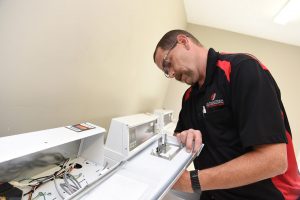Small changes to make a big impact on your bottom line.
There’s a dirty word in the laundry world: rewash.
Large rewash volumes waste time and resources, however, it can be reduced by implementing a few process changes. From the equipment, to chemicals, to sorting soil types these strategies can aid in achieving maximum linen life and save a lot of money.
Tip #1: The Proper Load Size Matters.
Mechanical action plays a huge part in the cleaning process, so that means laundry workers need to be properly trained on load sizes.
The right size of each load matters. That means not too little and not too much.
If the washer is underloaded, the linen will remain suspended, drastically reducing the mechanical action of the load. Also, underloading will mean too much chemical is being used, which isn’t good for linen life or your bottom line. On the contrary, f the washer is overloaded, the linen will not have enough room to move in the wash wheel, reducing the amount of mechanical action necessary to obtain good wash results.
We suggest to review your staff is well-informed on what a full load looks like in the washer. Not sure what that looks like yourself? Ask one of our team members to show you the next time we come out for a service call and we would be happy to show you!
Tip #2: Practice Good Sorting.
In laundry, it’s important to train employees on proper sorting for soil classes.
We suggest to train your soil sorters to inspect the linens as they are being sorted into three categories: light soil, heavy soil and rewash, If all the linens are sorted into the same cart and washed on the same formula, you are creating more rewash.
Here is a general sort method commonly used.
- Regular wash formula for lightly soiled items.
- Heavy-soil wash formula for the heavier-soiled items.
- The rewash formula for items that are stained or may have mildew on them.
Lastly, if there is a stain that needs special attention, ask employees to spot the stain by hand before it is washed.
The most critical step to take in reducing rewash is pre-sorting like items and soil level. While a high percentage of facilities are already doing this, it never hurts to remind employees and make sure new employees are well-trained on this.
Tip #3: The Right Machines Matter.
There is an old adage: “The right tool for the right job.” In laundry, that means having machines that have the mechanical action and controls needed to wash linens.
Equip the laundry with machines that feature flexible controls because this has the ability to tailor the wash process to the specific soil level and linen type. Rewash often is born of a laundry ‘generalist’ mentality, which is all loads get the same wash program. In the wash wheel, it’s all about time, temperature, chemistry and mechanical action. If you machines are older and do not have the ability to program like this, we suggest you consider looking into our lease program. You will save 10% if you have chemicals with us, and if eligible, we can buy your old equipment from you. You can learn more about that here.
Tip #4: Make Sure The Programming is Set For You.
Soil sorting and load size won’t help laundry quality all that much if correct wash programs aren’t being used on the proper soil and linen types.
Flexible controls on the equipment to shift wash programs is only the start, as with training staff on sorting and load sizes. We believe managers need to make sure staff is trained on what wash cycles should be used with specific linens and types of soil.
This is where equipment networked to a laundry management system is extremely valuable,. Our machines give managers the ability to review reports to gain a view of what cycles are being selected. Not sure if your equipment is programmed right? We can do a free laundry room consult to check all your programming and chemicals being used to help you understand your laundry room and ensure your equipment is doing the job right. You can sign up for that here.
Tip #5: Make Sure you Have The Proper Utilities For Your Programmed Cycles.
You can have the proper equipment, the correct wash programs, and soil and loads ready to go, but if the laundry’s utilities can’t provide the necessary power, effectiveness is reduced. For instance, chlorine bleach requires a hot water temperature of 140 degrees (F) to be effective and color-safe bleach requires a temperature of 160 degrees – If your utilities aren’t reaching this temperature, you are using too much chemical on linens which leads to lower linen lifetime and can cause skin irritation for customers.
Your provider should have done this at the time of installation and during any service checks, but it never hurts to ask them to double check that there is proper utility support during your next service check.
Tip #6: Cleanliness Starts BEFORE the Wash Cycle.
Laundry operations can put a lot of time and effort into processing linens properly, but there is still a way they can end up with increased rewash: a dirty plant and dirty carts.
Maintaining a clean plant and carts will help minimize the amount of rewash a laundry experiences.
Implement process that involve cleaning the production area daily to keep the cleanliness all parts of the process under control. We suggest to clean your carts after soiled linen has been transported in them because it will help to reduce incidental rewash as the linen is being moved through the facility.
Tip #7: Fine Tune
It takes diligence to maintain equipment and wash formulas in order to produce quality goods and reduce rewash—and save money.
We suggest you really work with your equipment distributor and chemical company to fine-tune wash programs and chemical dosing. Keeping the proper balance is key to delivering excellent results.









